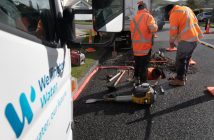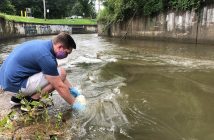Decentralised infrastructure can contribute to resilience – and water and wastewater utilities should engage with this potential, Dr Lynn Broaddus says
![]()
Applications for decentralised, or distributed, water and wastewater systems span a great deal of the managed water cycle, from capturing rainwater and stormwater through to wastewater treatment. Such approaches are gaining added impetus because of their potential as a response to key challenges such as congestion in crowded cities and the pressures of climate change.
Dr Lynn Broaddus, President of Broadview Collaborative, Inc. and next year’s President of the Water Environment Federation, believes decentralisation has a key role to play for climate-smart utilities, especially in terms of supporting adaptation to the effects of a changing climate. She recently authored a report outlining the opportunities she sees.
A role for utilities
Dr Broaddus likens the current situation to that of decentralised solar power a few years ago. “There were a lot of [power]utilities who fought it tooth and nail, who thought it was a threat to their business model,” she says. Similarly, there were others who saw it as an opportunity. For water, she warns that “it’s really important to get it right – you don’t want to be contaminating water. There are technical challenges. There is a role for utilities, and no reason why they can’t be a provider of distributed technology, or a supporter. It requires a change of mindset.”
There are cities that have already gone down that path, and Broaddus points to San Francisco as a leader, which has recognised the distributed model as a part of the fabric of development. “San Francisco is very progressive, it has put a high value on sustainable technologies and has developed codes, ordinances and standards to progress their use,” she says.
San Francisco Public Utilities Commission’s new headquarters is a prime example, with wastewater treated on site for non-potable uses via the Commission’s ‘Living Machine’, based around an engineered wetland system. Developers also realise that prospective tenants or buyers put a value on this sort of resilient distributed solution, she notes. This means they, in turn, are a force for change.
In Broaddus’ view, decentralisation covers many different aspects of the industry, potentially, not just wastewater treatment. She feels decentralised rainwater treatment, for example, does not get as much attention as it should. “Where people have their own roofs and temperate climate, rainwater can be part of a distributed system.”
The local context
What needs to be done will depend on the local context, she says. “In constrained cities, there is probably a role for developers and city leaders to look to distributed technologies at a district level, with buildings and technologies for reuse for non-potable uses,” says Broaddus, adding that she sees there are still some hurdles for onsite potable reuse in the US.
New York has also been a leader in decentralised wastewater, she explains, because of the constraints imposed by the existing extensive wastewater system. “Improvements [to this]would require a lot of digging and disruption. It was recognised that a distributed way of achieving growth would not put pressure on the system.” The Battery Park area of Lower Manhattan, for example, has permitted several high-rise buildings to have onsite wastewater treatment systems in their basements, a development that started in the early 2000s, Broaddus notes.
“For smaller urban areas that are experiencing growth, or trying to grow, or more likely have regulations that require cleaner water than has been achieved, putting in a large plant is very expensive,” Broaddus continues. “It is very hard to project growth and the technologies needed. Even with population growth, you may not get the increase in water use; fixtures are more efficient today. Within industry, there are a lot of efficiencies being made. Growth projections may not necessarily be realised, and they could be stuck paying for something more than they need. It becomes very challenging for small communities in the US, you see the struggles and even bankruptcies,” she observes. An alternative strategy is to adopt scalable technologies that can be built on as needed, which means that solutions become more affordable and manageable.
There is also a huge need in rural areas, Dr Broaddus adds. “These are traditionally on septic systems, but it is hard to maintain these, and to supply the water demanded by a traditional flush system. There are more and more individual-scale systems that use less water and create lower pollution levels. The pollution is a consequence of the water carrying the pollutants – if you use less water, there is an opportunity to separate out the pollutants as fertiliser.”
This leans towards the types of waterless system into which Broaddus says the Bill and Melinda Gates Foundation, for example, has been promoting research. “When people look at their work, they think of developing countries that are replacing zero sanitation, and this is very, very important on a global scale. In my perspective, that work can be supported and spun off. There are a lot of technologies that are very appropriate to rural areas in developed countries, and even maybe more densely populated areas. These should not be viewed as something only for poor people; there will be applications for everybody, especially in areas where it is challenging to put in a conventional wastewater treatment plant.” This would include, for example, the many communities that are sited on bedrock, she says.
Regulation and a roadmap
Of the many different technologies available, Broaddus points to those that separate urine from other waste streams. “It is a fairly easy to treat component, high in nutrients, and has a high value as fertiliser.” Even without taking that major step, “there are options that fit very nicely in conventional homes – the biggest barrier is around codes and standards. There is a lot to work though; it takes years to get adopted so that you can use the technologies without having to get some sort of special exemption,” she says.
In the US, affordability is a hot topic, she adds, especially this year with COVID-19 stretching finances. “When you talk about rate structures and government subsidies, it is also about what we build. Systems that are large, centralised, expensive to build and maintain – I believe you can get just as good experience with a home system, in terms of quality. We can have a much better environmental footprint if we rethink how we do things.
“I am always surprised at the number of really smart leaders in the water industry who predict that distributed technology is the way we need to go,” she says. There is not, as yet, a roadmap for how to get from this aspiration to implementation. “Our challenge right now is figuring out how to get there, and creating the beginning of the pathway,” she says.
Onsite opportunities in Austin, Texas
Austin, Texas, faced with a growing population and a constrained water supply, recently passed its “Water Forward” plan, which includes what is probably the most aggressive water harvesting plan in the US, according to the report Opportunities in distributed water infrastructure. By 2040, the city wants to be capturing and treating 100 million gallons per year through onsite resources.
Though onsite sewage treatment will provide some of that capacity, the focus is on capturing and re-using rainwater, cooling system condensate, and similar low-cost, easy-to-purify sources of water. Codes, ordinances, and oversight have not necessarily caught up to the plan or to localised enthusiasm. According to Sharlene Leurig, CEO of Texas Water Trade and chair of the Water Forward Commission, there’s a strong need for an investor-owned utility with deep experience in onsite water management to manage what is now a laissez-faire environment.
Developers are responding to the opportunity and are actively seeking partnerships with the handful of private utilities that are experienced with onsite, urban water treatment. For the city’s new municipal building, set to open in 2021, the developer is partnering with Sustainable Water to install and operate its ‘WaterHub’, a proprietary wastewater reclamation and reuse system. The Austin project will recycle 5000 gallons per day, to be used for toilets and landscape irrigation, though they have much larger operations (up to 1 million gallons per day) in operation elsewhere.




